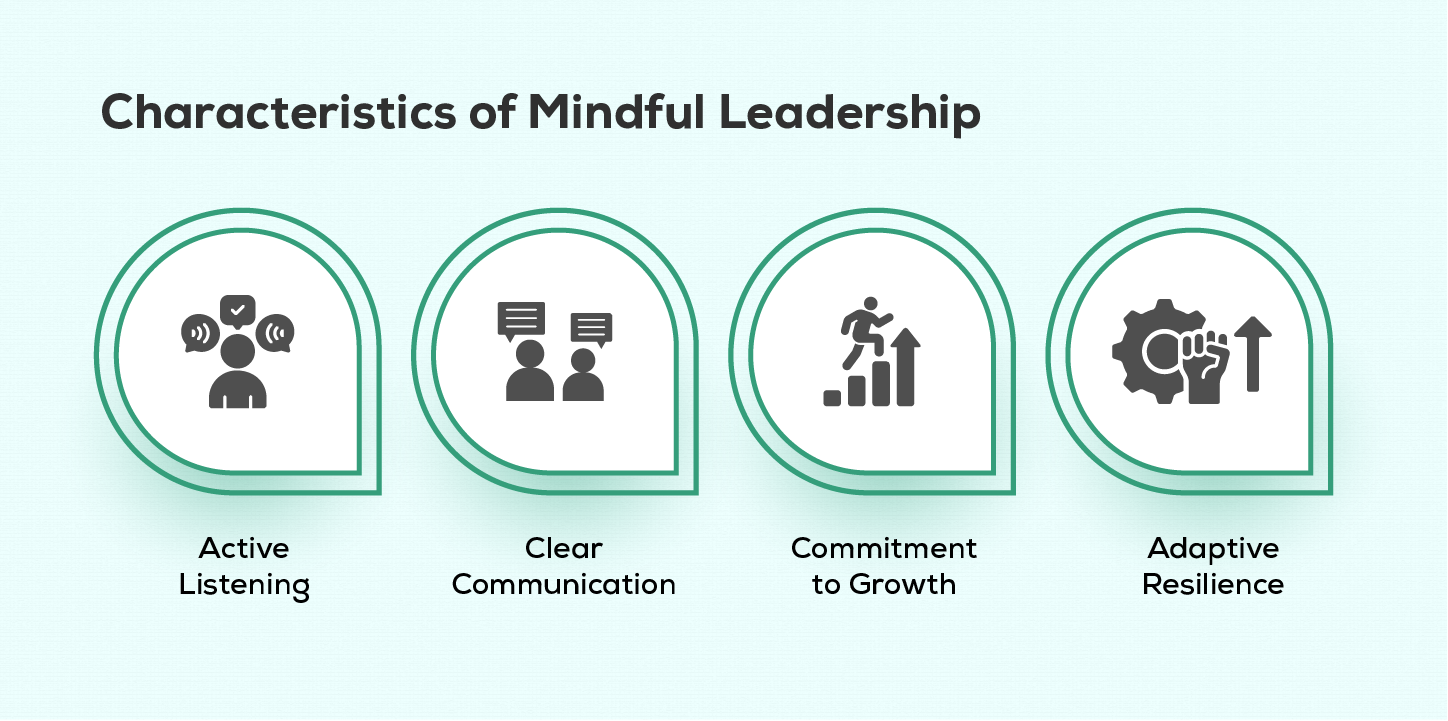In a high-pressure work environment where tight deadlines are the norm, stress often becomes a pervasive element. Amidst the challenging demands of meeting targets, a mindful leader emerges as a beacon of stability. Composed and clear-headed, this leader steers their team through challenges with empathy and thoughtful guidance. This approach epitomizes the essence of mindful leadership in the modern workplace.
What is Mindful Leadership?

In contemporary leadership, success is defined not merely by one’s title but by the ability to inspire, adapt and effectively navigate change. Mindful leadership equips leaders stay present, manage their emotions and deeply understand their teams for better decision-making and cultivating a more positive work environment. This approach demands constant self-improvement and a deep connection within the team. Mindful leadership offers a fresh perspective, emphasising self-awareness and empathy, bridging the gaps and empowering more teams.
By promoting mindfulness, leaders encourage teamwork, boost morale and enable employees to build stronger relationships with clients and customers, thereby driving team success.
Pillars of Mindful Leadership
The pillars of mindful leadership form the essential framework that supports leaders in guiding their teams effectively. They help leaders enhance self-awareness, nurture empathy and improve communication creating a positive and inclusive work environment. Let’s understand these pillars in detail:
1. Compassion
Compassion works beyond empathy! It allows one to connect with others’ feeling and motivates one to help them overcome challenges and advance their goals. The leader is both gracious and compassionate, recognizing their own journey of growth. A mindful leader strives to see the best in others, provides constructive feedback, and encourages them to fully realize their potential.
2. Emotional Intelligence
At the heart of mindful leadership lies emotional intelligence, which involves adept handling of personal emotions and the ability to empathize with others. Leaders who keep their cool under stress and stay emotionally connected provide a stabilizing and supportive environment for their teams.
According to a study conducted by the Mindful Leadership Institute, 93% of leaders reported that mindful training significantly enhances the ability to create an environment that nurtures innovation.
3. Creativity and Consistency
In leadership, balancing creativity and consistency is crucial. A mindful leader doesn’t just manage tasks but also sets clear expectations and encourages team members to bring in fresh ideas and innovative solutions. Promoting an environment of open communication, they enhance creativity and ensure project consistency. Recognizing and valuing team contributions directly boosts project success.
4. Clear Focus
To effectively guide their teams, leaders must maintain a clear focus on organizational goals and customer needs. Their full presence and undivided attention help engage employees, deepening their grasp of these objectives. This sharp focus enables thorough analysis and effective management of tasks from the simplest to the most complex, leading to successful outcomes. Integrity, trust, and a positive mindset further enable team members to overcome obstacles.
5. Visionary Thinking
A visionary leader doesn’t just dream of the future—they take action to turn vision into reality. This requires a growth mindset, continuous learning, and a willingness to experiment with new ideas. Visionary thinking extends beyond daily tasks, setting the stage for innovation, strategic progress, and transformation. Leaders with this perspective inspire creativity, challenge limitations, and encourage teams to explore new possibilities, driving long-term success.
Characteristics of Mindful Leadership

Becoming a mindful leader is gradual process that requires time, effort and patience to achieve. By developing some fundamental qualities, leaders can have lasting impact on their teams. Given below are the key characteristics of mindful leadership:
1. Active Listening
Active listening is a practice of giving someone your full attention and truly understanding their message. This powerful skill strengthens trust and collaboration, leading to more meaningful interactions. It includes benefits such as improving business communication, boosting employee morale, encouraging new ideas and perspectives, reducing employee turnover and enhancing overall communication skills.
2. Clear Communication
Clear communication is a key trait of effective leadership, ensuring that ideas, expectations, and feedback are conveyed with precision and understanding. It fosters trust, minimizes misunderstandings, and strengthens team dynamics. Clarity and active listening form the foundation of impactful communication, helping leaders guide their teams with confidence.
3. Commitment to growth
Commitment to growth is a defining trait of mindful leaders. They continuously refine their skills while supporting the development of their teams. Through training, coaching, and mentorship, they deepen understanding, flexibility, and self-awareness, improving their leadership effectiveness. This dedication promotes inclusivity, and advancing resilience in navigating challenges.
4. Adaptive Resilience
Resilience is a defining trait of mindful leadership, enabling leaders to navigate uncertainty, adapt to change, and recover from setbacks with clarity and purpose. They recognize that challenges are opportunities for growth and lead by example, demonstrating how to approach difficulties with a positive attitude and a learning mindset. When employees trust their leaders, they become more resilient in facing obstacles and embracing change.
Realtime Examples of Mindful Leadership
Mindful leadership is a proven approach embraced by successful leaders across industries. These real-world examples highlight its impact on effective leadership:
1. Sundar Pichai
Sundar Pichai, the CEO of Alphabet Inc. and Google exemplifies resilience in leadership. His journey offers a valuable lesson stating that challenges are not roadblocks, but growth opportunities. Inspired by his approach, resilient leaders embrace obstacles as chances to innovate, learn and succeed. He prioritizes employees’ mental well-being and actively encourages them to think creatively.
2. Tenzin Gyatso
Tenzin Gyatso, the 14th Dalai Lama, advocates compassion, empathy, and mindfulness as essential qualities for leaders of all backgrounds. His principles center around non-violence, tolerance and ethical behaviour, offering valuable guidance for leadership across various domains.
3. Marc Benioff
Marc Benioff, founder and CEO of Salesforce, focuses on belonging, inclusion and equality. Additionally, he advocates environment sustainability, gender equality, and corporate social responsibility recognizing them as key drivers for success.
Mindful Leadership Exercises
Mindful leadership exercises help leaders develop self-awareness, emotional intelligence, and inner strength. These simple yet impactful practices improve decision-making, reinforce leadership presence, and maintain harmony in the workplace.
- Mindfulness Meditation - Set aside time daily for quiet reflection, focusing on the breath and observing thoughts without judgment to cultivate inner clarity and calm.
- Gratitude Journal - Write down three things you’re grateful for each day to shift focus towards positivity and develop a mindset of appreciation.
- Goal Visualization - Picture yourself overcoming challenges, achieving goals, and embodying your ideal leadership qualities to boost confidence and motivation.
- Sensory Check-In - Engage all five senses to stay grounded in the present moment, reducing stress and enhancing focus.
- Appreciation Circle - Regularly gather with peers to express gratitude and share positive experiences, reinforcing a culture of recognition and support.
How to Implement Mindfulness at the Workplace?
Building a mindful culture starts with a mindful leader. By prioritising this approach, leaders encourage their teams to invest in team well-being and build a healthy work environment. A thriving organisation is built on a mindful and supportive culture that supports employee success.

1. Building a Mindful Environment
Adjusting lighting, noise levels and overall comfort creates a space that promotes mindfulness, leading to a more focused work environment. Small changes such as adding plants to your cabin, relaxing during break time and providing comfortable seating to the employees can make employees feel valued ultimately leading to productivity.
2. Employing Technology to Adopt Mindfulness
Encouraging teams to use applications like Headspace, Calm and Insight Timer helps them integrate mindfulness into their daily practice. These applications help in monitoring breathing patterns and providing guided mindfulness exercises for relaxation and focus.
3. Mindfulness Trainings
Providing mindful programs through online sessions, seminars, online courses and certifications helps employees to incorporate mindfulness in their work routines. These trainings provide practical skills that improve concentration and overall well-being, both in personal and professional lives.
Conclusion
Mindful leadership isn’t optional—it’s essential. Leaders who practice mindfulness regulate stress, make thoughtful decisions, and create a work culture where employees perform at their best. This practice is embraced by top leaders across the world, as it cultivates emotional intelligence, builds workplace connections, and supports holistic growth. When mindfulness becomes a leadership priority, it empowers teams, fuels achievement, and drives long-term success.







